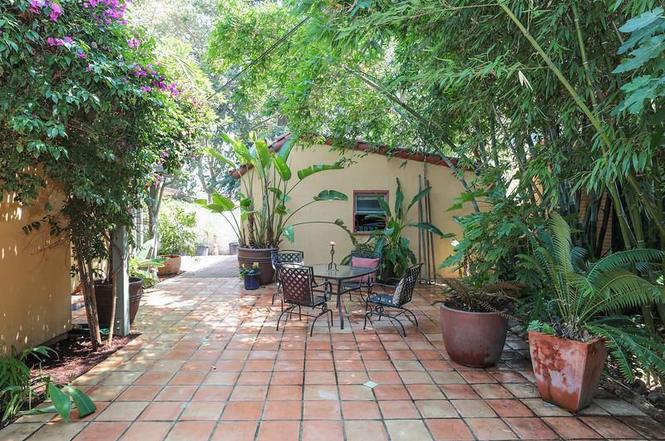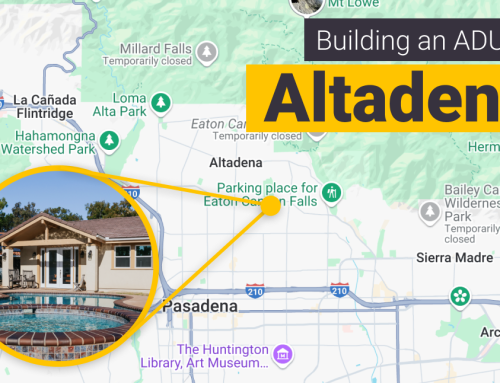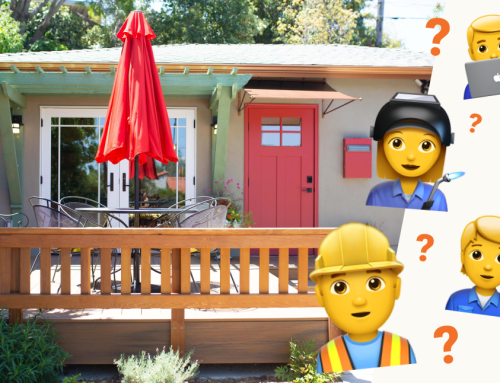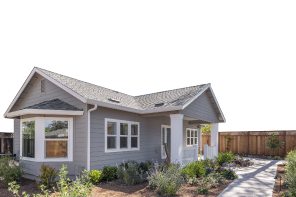If you’re thinking about purchasing an investment property with accessory dwelling unit (ADU) potential or evaluating your existing home, here are some characteristics to look for that make a property ideal for your project.
You can also download our free tool kit for an easy way to get started.
Ideal ADU Property Trait #1: Detached Garage

A detached garage is the low hanging fruit for homeowners interested in putting a second rentable unit on their property. Garage conversions are great for several reasons.
First, they tend to be the least expensive option. They make a great one bedroom or studio apartment and tend to be around 500 square feet. Above you’ll see a fantastic garage conversion being rented as an upscale Airbnb.
Some homeowners expand the footprint of their garage, which is certainly an option, but keeping the existing footprint will be less expensive. Check out this garage conversion in LA which features vaulted ceilings and an expanded footprint.
Garage conversions also have the added benefit of being able to be placed on the property line in California, meaning homeowners don’t have to conform to setback requirements. For tips and advice on converting a garage, read this article.
Ideal ADU Property Trait #2: Alley Access

Alley access is especially beneficial if you plan to use your accessory dwelling unit as a rental as opposed to family.
The big benefit here is that it maintains the privacy of both the homeowners living in the primary dwelling and the renters living in the ADU. Renters can drive into their driveway in the alley and walk straight into their ADU, which means you don’t have someone walking past your home and into your backyard daily.
An added benefit, your construction crew will appreciate having the alley to transport materials straight to the ADU. This will lessen the blow of traffic on the main street in front of your house and keep disruptions to your neighbors to a minimum. Out of sight, out of mind.
Ideal ADU Property Trait #3: Deep Lot
A deep lot is great, although not necessary to put in an ADU. Having a deep lot allows there to be more privacy and separation between the main home and the ADU.
It also gives homeowners the opportunity to keep some of their yard and outdoor space.
If you have the space designing and landscaping the yard so that both units have some outdoor space makes a big difference in the quality of living. Transforming outdoor space with string lights and patio furniture is much cheaper than building additional square footage, but can have a huge impact on livability.
But, just a heads up, the farther back on the lot you decide to place the ADU, the more expensive it’ll be to trench for utilities. Utilities are often connected to a main line running down the front of the property. More distance, more trenching, more dollars. We go more into this concept in our e-course. Catch a free preview of the course here.
Ideal ADU Property Trait #4: Great Neighborhood

Accessory Dwelling Units are perfect for dense urban areas that are close to high-density transit corridors, shops, restaurants, and walkability, just like this photo in downtown San Jose.
Additionally, homeowners who own homes in great neighborhoods tend to see the value of their homes increase at a faster pace providing access to home equity to fund their ADU project. (Check out other methods to finance an ADU here)
Homeowners building for passive rental income will especially want to look for this trait. Housing in walking distance to trendy neighborhoods are quick to get rented out.
Ideal ADU Property Trait #5: High Rents
Touching on our last point, if your goal is passive rental income it helps to live in a neighborhood that can command high rents. ADUs give renters access to neighborhoods that might not typically be able to afford and often times better school districts. Check out this homeowner that now rents his Berkeley garage conversion ADU to a young mother and her daughter.
Ideal ADU Property Trait #6: Duplex Property

Single-family properties aren’t the only places you can build an ADU. ADUs can be built on duplex, triplex, and other multi-family properties as well. Thanks to SB1211, you can now build one detached ADU per housing unit on the property to a maximum of eight. Essentially, you can double the amount of individual living spaces on a property! This is also in addition to converting any existing space like a recreation room or garage.
If you’re looking to discuss option, book a free appointment with Maxable Space and we can help you figure it out.
Ideal ADU Property Trait #7: Driveways

Most properties are not required to add an off-street parking space for their ADU, but if you are required to put in additional parking, having a driveway is extremely convenient!
What exactly does the city define as a parking space?
A parking space is defined as a 9.5×18’ hardscaped space, which means it can’t be gravel or dirt.
So how does the driveway come in?
A driveway can count as your parking requirement, even if it already exists! Even better, the city allows your parking requirement to be fulfilled tandem in a driveway as well.
Ideal ADU Property Trait #8: Half Mile from Public Transit
For homeowners within .5 miles of public transit, you aren’t required to add any parking when building your accessory dwelling unit. The idea behind this is increasing density in urban areas where access to public transportation is easy.
Ideal ADU Property Trait #9: NOT in a Coastal Zone
An ADU by the beach may sound like a dream, but when building in a Coastal Zone, you’re going to run into some extra obstacles. Building an ADU within these areas requires extra permissions from the city, and sometimes some extra fees as well.
How do you know if a property is in a Coastal Zone?
The California Coastal Commission defines a Coastal Zone as any area “extending inland generally 1,000 yards from the mean high tide line of the sea. In significant coastal estuarine, habitat, and recreational areas it extends inland to the first major ridgeline paralleling the sea or five miles from the mean high tide line of the sea, whichever is less, and in developed urban areas the zone generally extends inland less than 1,000 yards.” If you’re unsure if your property lies within this region you can contact your local planning department to confirm.
Check out our interview with a San Diego architect to get for details.
Ideal ADU Property Trait #10: Flat Lot
A lot of people don’t think about the slope of a lot, but it matters! Sloped lots are significantly more effort to prepare for a build. The grading of a steeply sloped lot can be expensive. If you’re looking for an investment property to build an ADU look for something flat.
With these 10 traits, you’re off to a great start when making considerations. If you’re ready to take the next step, contact Maxable today to set up a free, no commitment consultation.
Plan, hire, and manage your ADU project with Maxable.
At Maxable, we believe that building an ADU should be fun and exciting. You shouldn’t have to be the one to deal with confusing obstacles like permitting snafus or ever-changing regulations. We’ll be by your side every step of the way and connect you to experienced designers and general contractors in your area to make sure your project goes as smoothly as possible.
Leave the headaches to us! Check your address and see what Maxable can do for your home during a free ADU Planning Call.








